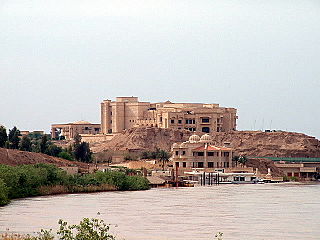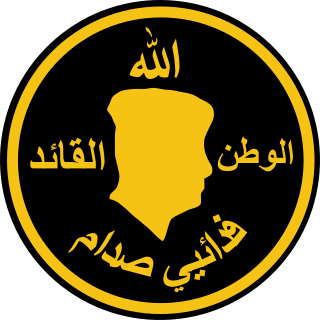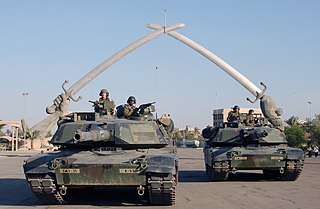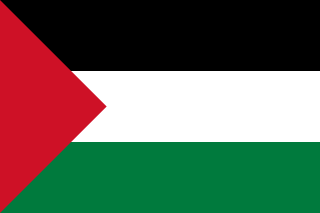
This is a timeline of the events surrounding the United States-led invasion of Iraq in 2003.

Tikrit is a city in Iraq, located 140 kilometers (87 mi) northwest of Baghdad and 220 kilometers (140 mi) southeast of Mosul on the Tigris River. It is the administrative center of the Saladin Governorate. As of 2012, it had a population of approximately 160,000.

Fedayeen Saddam was a paramilitary Fedayeen organization intensely loyal to the Ba'athist Iraqi government of Saddam Hussein. The name was chosen to mean "Saddam's Men of Sacrifice". At its height, the group had 30,000–40,000 members. The Fedayeen operated completely outside the law, above and outside political and legal structures.

The Battle of Baghdad, also known as the Fall of Baghdad, was a military engagement that took place in Baghdad in early April 2003, as part of the invasion of Iraq.

The president of the Republic of Iraq is the head of state of Iraq and "safeguards the commitment to the Constitution and the preservation of Iraq's independence, sovereignty, unity, the security of its territories in accordance with the provisions of the Constitution". The president is elected by the Council of Representatives by a two-thirds majority, and is limited to two four-year terms. The president is responsible for ratifying treaties and laws passed by the Council of Representatives, issues pardons on the recommendation of the prime minister, and performs the "duty of the High Command of the armed forces for ceremonial and honorary purposes". Since the mid-2000s, the presidency is primarily a symbolic office, as the position does not possess significant power within the country according to the October 2005-adopted constitution. By convention, though not by any official legal requirement, the office is expected to be held by a Kurd.

The following is a timeline of major events during the Iraq War, following the 2003 invasion of Iraq.
The Victory Arch, officially known as the Swords of Qādisīyah, and popularly called the Hands of Victory or the Crossed Swords, are a pair of triumphal arches in central Baghdad, Iraq. Each arch consists of a pair of outstretched hands holding crossed swords. The two arches mark the two entrances to Grand Festivities Square and the parade ground constructed to commemorate the Iran–Iraq War, started and led by Iraq's then-president Saddam Hussein. The arches were opened to the public on 8 August 1989. It is one of Baghdad's visitor attractions and near to the Monument to the Unknown Soldier.

Al-Iskandariya or Alexandria is an ancient city in central Iraq, one of a number of towns in the Near East founded by and named after Alexander the Great. It is a majority Shia Arab district including Musayyib and Jurf Al Sakhr. The district capital is located about 70 kilometres (45 mi) south of Baghdad, near the Euphrates River.

The Iraqi Special Republican Guard (SRG), also known as the Special Forces Brigade of the Presidential Palace, Republican Guard Special Protection Forces, or the Golden Division, was an Iraqi personal security force founded in either early 1992 or March 1995 in Ba'athist-era Iraq. The Special Republican Guard was controlled by the Special Security Organization and charged with protecting President Saddam Hussein, presidential sites, Baghdad, and responding to any rebellion, coup, or other threat to his power.

The Green Zone is the most common name for the International Zone of Baghdad. It is a 10-square-kilometer (3.9 sq mi) area in the Karkh district of central Baghdad, Iraq, and the seat of the Iraqi government.

The Republican Palace is a palace in Baghdad, Iraq, constructed on the orders of King Faisal II. It was Saddam Hussein's preferred place to meet visiting heads of state. The United States spared the palace during its shock and awe raid during the 2003 invasion of Iraq, in the belief that it might hold valuable documents. The Green Zone developed around it. The palace itself served as the Multi-National Force – Iraq Headquarters of Coalition troops during the U.S. Occupation of Iraq as well as the primary base of operations for the American diplomatic mission in Iraq until the opening of the new US Embassy in Baghdad in 2009.

The 1991 Iraqi uprisings were ethnic and religious uprisings against Saddam Hussein's regime in Iraq that were led by Shia Arabs and Kurds. The uprisings lasted from March to April 1991 after a ceasefire following the end of the Gulf War. The mostly uncoordinated insurgency was fueled by the perception that Iraqi President Saddam Hussein had become vulnerable to regime change. This perception of weakness was largely the result of the outcome of the Iran–Iraq War and the Gulf War, both of which occurred within a single decade and devastated the population and economy of Iraq.

Al-Karkh or just Karkh is historically the name of the western half of Baghdad, Iraq, or alternatively, the western shore of the Tigris River as it ran through Baghdad. The eastern shore is known as al-Rusafa. Historically, al-Karkh has been a commerce market during the Abbasid Caliphate, located outside the main Round City due to safety concerns. It saw many exports and was the main business place for merchants and craftsmen. Al-Karkh has also historically suffered from infighting, fire, and floods that impacted its population and topography.

Al-Faw Palace is a palace located in Baghdad approximately 5 km from the Baghdad International Airport, Iraq. Former Iraqi president Saddam Hussein commissioned its construction in the 1990s to commemorate the Iraqi forces' re-taking of the Al-Faw Peninsula during the Iran-Iraq War. It was said that Saddam used the palace for duck hunting.
Radwaniyah Palace is a palace in Baghdad, Iraq, which is the official residence of the President of Iraq and also functioned as a presidential resort for the late Iraqi president Saddam Hussein until it was taken over by Coalition forces during the 2003 US-led invasion of Iraq. The complex spans 18 square kilometres.

The Battle of the Karbala Gap occurred during the 2003 invasion of Iraq. The Karbala Gap is a 20–25-mile wide strip of land with the Euphrates River to the east and Lake Razazah to the west. This strip of land was recognized by Iraqi commanders as a key approach to Baghdad, and was defended by the Medina and Bakhtnisar Divisions of the Iraqi Republican Guard. American forces attacked Iraqi forces in the area with massive air attacks followed by concentrated armored thrusts which resulted in the Iraqi units being surrounded and annihilated.
Victory Base Complex (VBC) was a cluster of U.S. military installations surrounding the Baghdad International Airport (BIAP). The primary component of the VBC was Camp Victory, the location of the Al-Faw Palace, which served as the headquarters for the Multi-National Corps - Iraq, and later as the headquarters for the United States Forces - Iraq.

Forward Operating Base Danger was a forward operating base operated by the United States Army in Tikrit, Iraq from the time of the occupation of Iraq in 2003 until November 2005 when it was handed over to the government of Iraq.

The Royal Tulip Al Rasheed Hotel is an 18-story hotel in Baghdad, Iraq, often visited by journalists and media personnel due to its location within Baghdad's Green Zone. It is named after the eighth century Caliph Harun Al-Rashid. It has been a focal point in a number of conflicts in the region, most recently the 2003 U.S. invasion of Iraq.

The November 1963 Iraqi coup d'état took place between November 13 and November 18, 1963, when, following internal party divisions, pro-Nasserist Iraqi officers led a military coup within the Ba'ath Party. Although the coup itself was bloodless, 250 people were killed in related actions.

















